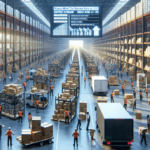Understanding Amazon's Shipping Delays: Causes and Solutions
Amazon, one of the world's largest online retailers, has been grappling with significant delays in order fulfillment over the past year. These delays have left many customers frustrated and dissatisfied. This article delves into the underlying causes of Amazon’s shipping delays, examines the impact of ongoing global challenges, and explores the strategies the company is implementing to address these issues.
Causes of Amazon's Shipping Delays
Surge in Online Demand
The COVID-19 pandemic has fundamentally altered consumer behavior, leading to a sustained increase in online shopping. According to Statista, global e-commerce sales grew by over 27% in 2021 alone. This surge has strained Amazon's logistics and fulfillment networks, making it challenging to maintain previous delivery speeds.
Workforce Challenges
Amazon’s fulfillment centers have faced significant workforce challenges, including staff shortages and increased turnover rates. Despite offering competitive wages, the physically demanding nature of warehouse jobs has contributed to higher employee turnover. Additionally, health concerns and social distancing measures have further reduced workforce capacity.
Prioritization of Essential Items
During peak periods of the pandemic, Amazon shifted its focus to deliver essential items such as medical supplies, groceries, and household essentials. This prioritization has inevitably led to longer delivery times for non-essential items, as resources are reallocated to meet the urgent demands of critical products.
Impact of Global Challenges on Shipping Operations
Supply Chain Disruptions
Global supply chain disruptions have had a profound impact on Amazon’s ability to source and deliver products efficiently. Issues such as port congestions, container shortages, and delays in international shipping have extended delivery times. According to a McKinsey report, these disruptions have increased lead times across various industries, including e-commerce.
Implementation of Safety Measures
To ensure the safety of its employees, Amazon implemented stringent safety protocols, including social distancing, enhanced sanitation, and mandatory health screenings. While essential for worker safety, these measures have slowed down operations and reduced overall efficiency.
Technological Investments and Innovations
In response to operational challenges, Amazon has invested heavily in automation and technology. The integration of robotics in warehouses and the use of machine learning algorithms to optimize logistics have helped improve efficiency. Additionally, Amazon has expanded its use of drones for delivery in select areas, aiming to streamline the shipping process.
Amazon's Strategies to Mitigate Shipping Delays
Expanding Fulfillment Centers
Amazon has continuously expanded its network of fulfillment centers globally to increase capacity. By establishing more localized warehouses, Amazon aims to reduce shipping distances and delivery times. This expansion is part of Amazon’s long-term strategy to enhance its logistics infrastructure.
Enhancing Workforce Capacity
To address workforce shortages, Amazon has ramped up recruitment efforts, offering incentives and signing bonuses to attract new employees. The company has also invested in training programs to improve workforce efficiency and reduce turnover rates.
Leveraging Third-Party Logistics Providers
Amazon collaborates with third-party logistics providers to handle overflow during peak periods. These partnerships help expand Amazon’s delivery capabilities without the need for immediate infrastructure investments.
Alternative Delivery Options for Faster Service
Same-Day and One-Day Delivery
For customers requiring urgent deliveries, Amazon offers same-day and one-day delivery options on eligible products. These services are available for an additional fee or as a benefit for Amazon Prime members, ensuring faster access to purchased items.
Amazon Prime Benefits
Amazon Prime members enjoy expedited shipping options, including free two-day shipping on a vast selection of products. Prime also offers benefits like unlimited access to streaming services and exclusive deals, enhancing overall customer satisfaction.
Amazon Locker Service
The Amazon Locker service provides a secure and convenient alternative to home delivery. Customers can choose to have their packages delivered to a nearby locker location and pick them up at their convenience, reducing the risk of missed deliveries.
Future Outlook for Amazon's Shipping Operations
Sustainable Shipping Practices
In response to growing environmental concerns, Amazon is investing in sustainable shipping initiatives. The company aims to achieve net-zero carbon emissions by 2040 by introducing electric delivery vehicles and utilizing renewable energy sources in its operations.
Local Fulfillment Centers
To further reduce shipping times, Amazon is exploring the establishment of smaller, localized fulfillment centers. These centers are strategically positioned closer to urban areas, enabling faster delivery and more efficient inventory management.
Regulatory Compliance and Data Privacy
As global regulations around data privacy and consumer protection evolve, Amazon must ensure compliance while maintaining seamless shopping experiences. Adapting to these regulatory changes is crucial for sustained operational efficiency and customer trust.
Comparing Amazon’s Shipping Performance to Other Retailers
Performance Amidst the Pandemic
While Amazon has faced significant shipping delays, other major retailers like Walmart and Target have also experienced similar challenges. However, Amazon's larger scale and higher order volumes have made its delays more noticeable to consumers.
Competitive Measures
Competitors have adopted various strategies to mitigate shipping delays, such as expanding their own fulfillment networks and enhancing partnerships with local delivery services. Amazon continues to lead with its technological innovations and extensive logistics infrastructure.
Conclusion
Shipping delays at Amazon are the result of a confluence of factors including increased online demand, workforce challenges, and global supply chain disruptions. While the company has implemented several strategies to address these issues, ongoing global challenges continue to pose significant hurdles. Moving forward, Amazon's investments in technology, expansion of fulfillment centers, and sustainable practices are critical to improving delivery times and enhancing customer satisfaction. As online shopping remains a dominant retail trend, Amazon's ability to adapt and innovate will be pivotal in maintaining its leadership in the e-commerce landscape.




















